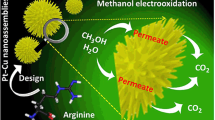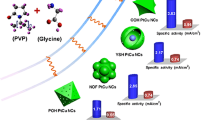Abstract
This paper demonstrates a one-pot approach to produce highly dispersed dendritic palladium-platinum bimetallic nanoparticles (NPs) with small particle size, tunable composition and high catalytic activity. Herein, the PdPt bimetallic NPs have been obtained using bayberry tannin (BT) as both the reducing agent and surfactant. Additionally, the PdPt bimetallic NPs with different Pd/Pt atomic ratios can be prepared by just varying the amounts of the Pd and Pt precursors. Most importantly, the as-prepared Pd52Pt48 catalyst exhibits the optimal catalytic activities compared with the other compositional PdPt NPs (Pd82Pt18, Pd69Pt31, and Pd36 Pt64) and commercial Pt/C (20 wt.%) catalyst for the methanol oxidation reaction (MOR). Meanwhile, Pd52Pt48 also shows better CO tolerance, which can be attributed to the unique dendritic structure and the synergistic effect between Pd and Pt. With evident advantages of the facile preparation and enhanced catalytic performance, it holds great promise as a high-performance catalyst for electrochemical energy conversion.
摘要
本文利用一步法制备了具有小粒径、组成可控和高催化活性的高度分散的枝状PdPt双金属纳米颗粒. PdPt双金属纳米颗粒通过单宁酸(BT)作为还原剂和表面活性剂得到, 起到了简化工艺的作用. 此外, 具有不同Pd/Pt原子比的PdPt双金属纳米颗粒可以通过改变Pd和Pt前 躯体的量来获得. 与其他成分PdPt纳米颗粒(Pd82Pt18, Pd69Pt31, Pd36Pt64)和商业Pt/C(20 wt.%)催化剂相比, Pd52Pt48催化剂具有最高的甲醇氧化电催化活性, 这归因于其独特的树枝状结构以及Pd和Pt之间的协同效应. 该研究具有易于制备和高催化性能的优点, 在电化学能量转换高性能催化剂方面具有巨大的应用前景.
Similar content being viewed by others
References
Wang Y, Chen K, Mishler J, et al. A review of polymer electrolyte membrane fuel cells: technology, applications, and needs on fundamental research. Appl Energ, 2011, 88: 981–1007
Fu Q, Li H, Ma S, et al. A mixed-solvent route to unique PtAuCu ternary nanotubes templated from Cu nanowires as efficient dual electrocatalysts. Sci China Mater, 2016, 59: 112–121
Shang C, Yang M, Wang Z, et al. Encapsulated MnO in N-doping carbon nanofibers as efficient ORR electrocatalysts. Sci China Mater, 2017, 60: 937–946
Asiri H, Anderson A. Mechanisms for ethanol electrooxidation on Pt(111) and adsorption bond strengths defining an ideal catalyst. J Electrochem Soc, 2014, 162: F115–F122
Wu Y, Wang D, Li Y. Nanocrystals from solutions: catalysts. Chem Soc Rev, 2014, 43: 2112–2124
Huang D, Yuan Q, Wang H, et al. Facile synthesis of PdPt nanoalloys with sub-2.0 nm islands as robust electrocatalysts for methanol oxidation. Chem Commun, 2014, 50: 13551–13554
Lu Q, Wang H, Eid K, et al. Synthesis of hollow platinum-palladium nanospheres with a dendritic shell as efficient electrocatalysts for methanol oxidation. Chem Asian J, 2016, 11: 1939–1944
Zhan F, Bian T, Zhao W, et al. Facile synthesis of Pd–Pt alloy concave nanocubes with high-index facets as electrocatalysts for methanol oxidation. CrystEngComm, 2014, 16: 2411–2416
Lim B, Jiang M, Yu T, et al. Nucleation and growth mechanisms for Pd–Pt bimetallic nanodendrites and their electrocatalytic properties. Nano Res, 2010, 3: 69–80
Peng Z, Yang H. Synthesis and oxygen reduction electrocatalytic property of Pt-on-Pd bimetallic heteronanostructures. J Am Chem Soc, 2009, 131: 7542–7543
Wang L, Nemoto Y, Yamauchi Y. Direct synthesis of spatiallycontrolled Pt-on-Pd bimetallic nanodendrites with superior electrocatalytic activity. J Am Chem Soc, 2011, 133: 9674–9677
Zhang Z, Luo Z, Chen B, et al. One-pot synthesis of highly anisotropic five-fold-twinned PtCu nanoframes used as a bifunctional electrocatalyst for oxygen reduction and methanol oxidation. Adv Mater, 2016, 28: 8712–8717
Eid K, Wang H, He P, et al. One-step synthesis of porous bimetallic PtCu nanocrystals with high electrocatalytic activity for methanol oxidation reaction. Nanoscale, 2015, 7: 16860–16866
Fu G, Ma R, Gao X, et al. Hydrothermal synthesis of Pt–Ag alloy nano-octahedra and their enhanced electrocatalytic activity for the methanol oxidation reaction. Nanoscale, 2014, 6: 12310–12314
Xia T, Liu J, Wang S, et al. Nanomagnetic CoPt truncated octahedrons: facile synthesis, superior electrocatalytic activity and stability for methanol oxidation. Sci China Mater, 2017, 60: 57–67
Xia B, Wu H, Li N, et al. One-pot synthesis of Pt–Co alloy nanowire assemblies with tunable composition and enhanced electrocatalytic properties. Angew Chem Int Ed, 2015, 54: 3797–3801
da Silva S, Silva J, Buzzo G, et al. Electrochemical and fuel cell evaluation of PtAu/C electrocatalysts for ethanol electro-oxidation in alkaline media. Int J Hydrogen Energ, 2014, 39: 10121–10127
Bian T, Zhang H, Jiang Y, et al. Epitaxial growth of twinned Au–Pt core–shell star-shaped decahedra as highly durable electrocatalysts. Nano Lett, 2015, 15: 7808–7815
Liu J, Chen B, Kou Y, et al. Pt-decorated highly porous flower-like Ni particles with high mass activity for ammonia electro-oxidation. J Mater Chem A, 2016, 4: 11060–11068
Wang Z, Lu C, Kong W, et al. Platinum nanoparticles supported on core-shell nickel-carbon as catalyst for methanol oxidation reaction. J Alloys Compd, 2017, 690: 95–100
Liu X, Cui C, Gong M, et al. Pt–Ni alloyed nanocrystals with controlled architectures for enhanced methanol oxidation. Chem Commun, 2013, 49: 8704–8706
Lee S, Park J, Park S. Roles of nitric acid treatment on PtRu catalyst supported on graphite nanofibers and their methanol electro-oxidation behaviors. Int J Hydrogen Energ, 2014, 39: 16468–16473
Li M, Zheng H, Han G, et al. Facile synthesis of binary PtRu nanoflowers for advanced electrocatalysts toward methanol oxidation. Catal Commun, 2017, 92: 95–99
Liu P, Yang D, Chen H, et al. Discrete and dispersible hollow carbon spheres for PtRu electrocatalyst support in DMFCs. Electrochim Acta, 2013, 109: 238–244
Yang Z, Xu S, Xie J, et al. Effect of nitrogen-doped PtRu/graphene catalyst on its activity and durability for methanol oxidation. J Appl Electrochem, 2016, 46: 895–900
Ji Y, Wu Y, Zhao G, et al. Porous bimetallic Pt–Fe nanocatalysts for highly efficient hydrogenation of acetone. Nano Res, 2015, 8: 2706–2713
Antolini E. Palladium in fuel cell catalysis. Energ Environ Sci, 2009, 2: 915–931
Sasaki K, Naohara H, Cai Y, et al. Core-protected platinum monolayer shell high-stability electrocatalysts for fuel-cell cathodes. Angew Chim Int Ed, 2010, 49: 8602–8607
Wu S, Zhu Y, Huo Y, et al. Bimetallic organic frameworks derived CuNi/carbon nanocomposites as efficient electrocatalysts for oxygen reduction reaction. Sci China Mater, 2017, 60: 654–663
Wang Q, Li Y, Liu B, et al. A facile reflux procedure to increase active surface sites form highly active and durable supported palladium@ platinum bimetallic nanodendrites. J Power Sources, 2015, 297: 59–67
Lai S, Fu C, Chen Y, et al. Pt-content-controlled synthesis of Pd nanohollows/Pt nanorods core/shell composites with enhanced electrocatalytic activities for the methanol oxidation reaction. J Power Sources, 2015, 274: 604–610
Liu Q, Xu Y, Wang A, et al. A single-step route for large-scale synthesis of core–shell palladium@platinum dendritic nanocrystals/ reduced graphene oxide with enhanced electrocatalytic properties. J Power Sources, 2016, 302: 394–401
Mukerjee S, Srinivasan S, Soriaga M, et al. Effect of preparation conditions of Pt alloys on their electronic, structural, and electrocatalytic activities for oxygen reduction-XRD, XAS, and electrochemical studies. J Phys Chem, 1995, 99: 4577–4589
Zhang G, Huang C, Qin R, et al. Uniform Pd–Pt alloy nanoparticles supported on graphite nanoplatelets with high electrocatalytic activity towards methanol oxidation. J Mater Chem A, 2015, 3: 5204–5211
Huang X, Wu H, Liao X, et al. One-step, size-controlled synthesis of gold nanoparticles at room temperature using plant tannin. Green Chem, 2010, 12: 395–399
Ho Kim Y, Nakano Y. Adsorption mechanism of palladium by redox within condensed-tannin gel. Water Res, 2005, 39: 1324–1330
Ha W, Yu J, Wang R, et al. “Green” colorimetric assay for the selective detection of trivalent chromium based on Xanthoceras sorbifolia tannin attached to gold nanoparticles. Anal Methods, 2014, 6: 5720–5726
Zhang J, Wan L, Liu L, et al. PdPt bimetallic nanoparticles enabled by shape control with halide ions and their enhanced catalytic activities. Nanoscale, 2016, 8: 3962–3972
Fan F, Liu D, Wu Y, et al. Epitaxial growth of heterogeneous metal nanocrystals: from gold nano-octahedra to palladium and silver nanocubes. J Am Chem Soc, 2008, 130: 6949–6951
Gao H, Liao S, Liang Z, et al. Anodic oxidation of ethanol on coreshell structured Ru@PtPd/C catalyst in alkaline media. J Power Sources, 2011, 196: 6138–6143
Tan XH, Prabhudev S, Kohandehghan A, et al. Pt–Au–Co alloy electrocatalysts demonstrating enhanced activity and durability toward the oxygen reduction reaction. ACS Catal, 2015, 5: 1513–1524
Wang W, Huang Q, Liu J, et al. One-step synthesis of carbonsupported Pd–Pt alloy electrocatalysts for methanol tolerant oxygen reduction. ElectroChem Commun, 2008, 10: 1396–1399
Lu S, Eid K, Ge D, et al. One-pot synthesis of PtRu nanodendrites as efficient catalysts for methanol oxidation reaction. Nanoscale, 2017, 9: 1033–1039
Chen D, Tong YY. Irrelevance of carbon monoxide poisoning in the methanol oxidation reaction on a PtRu electrocatalyst. Angew Chem Int Ed, 2015, 54: 9394–9398
Lebedeva N, Rodes A, Feliu J, et al. Role of crystalline defects in electrocatalysis: CO adsorption and oxidation on stepped platinum electrodes as studied by in situ infrared spectroscopy. J Phys Chem B, 2002, 106: 9863–9872
Zhang X, Guan P, Malic L, et al. Nanoporous twinned PtPd with highly catalytic activity and stability. J Mater Chem A, 2015, 3: 2050–2056
Acknowledgements
This work was supported by the National Natural Science Foundation of China (51571151, 51701139, 51671143, 51371119 and U1601216).
Author information
Authors and Affiliations
Corresponding author
Additional information
Yuan Zhang was born in 1992. She received her bachelor’s degree from the School of Material Science and Engineering, Yanshan University, in 2015. She is now a graduate student at Tianjin University. Her research interests focus on the synthesis and characterization of platinum (Pt)-based nanomaterials for electrocatalytic applications.
Jinfeng Zhang received her PhD from the Department of Materials Science and Engineering, Shanghai Jiao Tong University, in 2016. She joined the Department of Materials Science and Engineering, Tianjin University in 2016. Her recent research interests focus on the design, synthesis, and characterization of nanostructured materials for electrocatalytic applications.
Yida Deng is a professor at the School of Materials Science and Engineering, Tianjin University. He received his PhD from Shanghai Jiao Tong University in 2006. His research interests include metal and metal oxide nanostructures for electrochemical and energy applications.
Electronic supplementary material
Rights and permissions
About this article
Cite this article
Zhang, Y., Zhang, J., Chen, Z. et al. One-step synthesis of the PdPt bimetallic nanodendrites with controllable composition for methanol oxidation reaction. Sci. China Mater. 61, 697–706 (2018). https://doi.org/10.1007/s40843-017-9157-9
Received:
Accepted:
Published:
Issue Date:
DOI: https://doi.org/10.1007/s40843-017-9157-9




